
- Oscillations Questions and Answers
Oscillations Questions and Answers
| 1. A person normally weighing 50 kg stands on a massless platform which oscillates up and down harmonically at a frequency of 2.0 s-1 and an amplitude 5.0 cm. A weighing machine on the platform gives the persons weight against time. (a) Will there be any change in weight of the body, during the oscillation? (b) If answer to part (a) is yes, what will be the maximum and minimum reading in the machine and at which position? |
| Explanation-a) the weight of the body changes during oscillations.
|
| 2. A body of mass m is attached to one end of a massless spring which is suspended vertically from a fixed point. The mass is held in hand so that the spring is neither stretched nor compressed. Suddenly the support of the hand is removed. The lowest position attained by the mass during oscillation is 4cm below the point, where it was held in hand. (a) What is the amplitude of oscillation? (b) Find the frequency of oscillation? |
| Explanation- when the support of the hand is removed the body oscillates about mean position Suppose x is the maximum extension in the spring when it reaches the lowest point in oscillation.
|
| 3. A cylindrical log of wood of height h and area of cross-section A floats in water. It is pressed and then released. Show that the log would execute S.H.M. with a time period. 2 m T A g π ρ = where m is mass of the body and ρ is density of the liquid. |
| Explanation- let the log be passed and the vertical displacement at the vertical displacement at the equilibrium position
|
| 4. One end of a V-tube containing mercury is connected to a suction pump and the other end to atmosphere. The two arms of the tube are inclined to horizontal at an angle of 45° each. A small pressure difference is created between two columns when the suction pump is removed. Will the column of mercury in V-tube execute simple harmonic motion? Neglect capillary and viscous forces. Find the time period of oscillation. |
| Explanation-let us consider an infinitesimal liquid column of length dx at a height x from horizontal line. |
| 5. A tunnel is dug through the centre of the Earth. Show that a body of mass ‘m’ when dropped from rest from one end of the tunnel will execute simple harmonic motion. |
| Explanation- the gravitational force on the particle at a distance r from the centre of the earth arises entirely from that portion of matter of the earth in shells internal to the positiin of the particles . the external shells exert no force on the particle.
|
| 7.A simple pendulum of time period 1s and length l is hung from a fixed support at O, such that the bob is at a distance H vertically above A on the ground (Fig) The amplitude is θ o . The string snaps at θ = θ0 /2. Find the time taken by the bob to hit the ground. Also find distance from A where bob hits the ground. Assume θ0 to be small so that sin o 0 and cos 0
|
| Explanation- let us assume t=0 when o then = 0coswt Given a seconds pendulum w=2 = At time t, let Cos2 , t1=1/6 =-( )sin2 t=t1=1/6 d =- sin the linear velocity is u=- the vertical component is Uy= the horizontal component Ux=- at the time it snaps the vertical height is H’=H+l(1-cos ) Let the time require for fall be t , then H’= H+l (1 ) Let the time required for fall be at t then H’=uyt+1/2 gt2 1/2gt2+ t= given that is small , hence neglecting terms of order and higher t= H’ t= the distance travelled in the x direction is uxt to the left of where the bob is snapped X= Uxt= cos X= At the time of snapping , the bob was at a horizontal distance of from A Thus, the distance of bob from A where it meets the ground is = = = |
Commonly asked questions
A person normally weighing 50 kg stands on a massless platform which oscillates up and down harmonically at a frequency of 2.0 s-1 and an amplitude 5.0 cm. A weighing machine on the platform gives the persons weight against time. (a) Will there be any change in weight of the body, during the oscillation? (b) If answer to part (a) is yes, what will be the maximum and minimum reading in the machine and at which position?
This is a long answer type question as classified in NCERT Exemplar
(a) The weight of the body changes during oscillations.
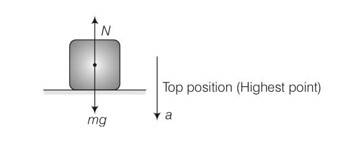
(b) Considering the situations in two extreme positions
we can say mg-N= ma
so at the highest point the platform is accelerating downward.
N=mg-ma
a=w2A
N=mg-mw2A
A= amplitude of motion m=50kg v=2m/s
w=2
A= 5cm = 5
N= 50
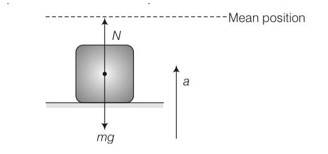
When it is accelerating towards mean position that is vertically upwards
N-mg=ma=Mw2A
N=mg+mw2A
N=m (g+w2A)
N= 50 [9.8+ ]
N= 884N
Machine reads the normal reaction
Maximum weight =884N
Minimum weight=95.5N
A body of mass m is attached to one end of a massless spring which is suspended vertically from a fixed point. The mass is held in hand so that the spring is neither stretched nor compressed. Suddenly the support of the hand is removed. The lowest position attained by the mass during oscillation is 4cm below the point, where it was held in hand. (a) What is the amplitude of oscillation? (b) Find the frequency of oscillation?
This is a long answer type question as classified in NCERT Exemplar
(a) When the support of the hand is removed the body oscillates about mean position
Suppose x is the maximum extension in the spring when it reaches the lowest point in oscillation.
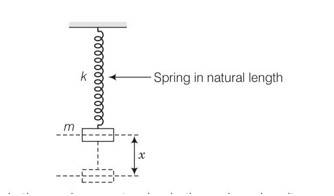
Loss in PE of the block=mgx
Gain in elastic potential energy =1/2 kx2
By energy conservation we cam say that
Mgx=1/2kx2
Or x= 2mg/k
Now the mean position of oscillation will be when the block is balanced by spring
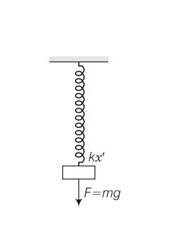
If x’ is the extension in that case
F= kx’
F=mg
Mg=kx’
X’=mg/k
By dividing x by x’
x/x’=
so x=2x’
x’=4/2 =2cm
but the displacement of mass from the mean position when spring attains its natural length is equal to amplitude of the oscillation
A=x’=2cm
(b) Time period of the oscillating system depends on mass spring constant given by
T=
2mg/k=x
2mg/k=4cm =4
m/k =4 /2g
k/m=g/2
= =3.51Hz
A cylindrical log of wood of height h and area of cross-section A floats in water. It is pressed and then released. Show that the log would execute S.H.M. with a time period. 2 m T A g π ρ = where m is mass of the body and ρ is density of the liquid.
This is a long answer type question as classified in NCERT Exemplar
Let the log be passed and the vertical displacement at the vertical displacement at the equilibrium position
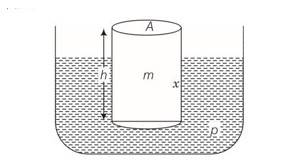
So mg= buoyant forces =
When it is displaced by further displacement x, the buoyant force is A (xo+x)
Net restoring force = buoyant forces -weight
=A (xo+x) -mg
=A
As displacement x is downward and restoring force is upward
Frestoring =-A =-kx
So motion is SHM
Acceleration a=Frestoring/m=-kx/m
a=-w2x
w2=k/m
w=
T= 2
One end of a V-tube containing mercury is connected to a suction pump and the other end to atmosphere. The two arms of the tube are inclined to horizontal at an angle of 45° each. A small pressure difference is created between two columns when the suction pump is removed. Will the column of mercury in V-tube execute simple harmonic motion? Neglect capillary and viscous forces. Find the time period of oscillation.
This is a long answer type question as classified in NCERT Exemplar
Let us consider an infinitesimal liquid column of length dx at a height x from horizontal line.
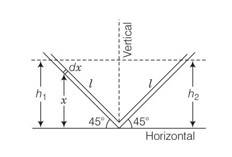
If density of the liquid
PE= dmgx=A
So total PE of the column
= =
But h1=lsin45
PE=A gl2sin245/2
Similarly PE of right column = A gl2sin245/2
Total PE = A gl2sin245/2+ A gl2sin245/2
= A gl2/2
If due to pressure difference is created y element of left side moves on the right side then liquid present in the left arm =l-y
But liquid present in the right arm =l+y
Total PE = PEfinal-PEinitial
Change in PE = ]
= =A
Change in KE = ½ mv2
m=A
change in KE= 1/2A =A
so from above eqn
change in PE +change in KE = A +A
system being conservative
so change in total energy =0
A =0
Differentiating both with respect to time t
A =0
Dy/dt =v and dv/dt=a
A
(gy+la)2A =0
2A and 2A
La+gy=0
A+(gy/l)=0
d2y/dt2+gy/l=0
d2y/dt2+w2y=0
w=
T=2
A tunnel is dug through the centre of the Earth. Show that a body of mass ‘m’ when dropped from rest from one end of the tunnel will execute simple harmonic motion.
This is a long answer type question as classified in NCERT Exemplar
The gravitational force on the particle at a distance r from the centre of the earth arises entirely from that portion of matter of the earth in shells internal to the positiin of the particles . the external shells exert no force on the particle.
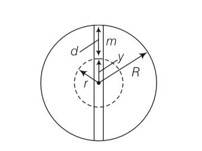
Let g’ be the acceleration at P
So g’ =g (1-d/R)=g (R-d/R)
R-d=y
g’=gy/R’
F=-mg’= -mgy/R
F
Ma=-Mgy/R, a = -gy/R
Comparing a=-w2y
w2=g/R
T=2
A simple pendulum of time period 1s and length l is hung from a fixed support at O, such that the bob is at a distance H vertically above A on the ground (Fig) The amplitude is θ o . The string snaps at θ = θ0 /2. Find the time taken by the bob to hit the ground. Also find distance from A where bob hits the ground. Assume θ0 to be small so that sin o 0 and cos 0
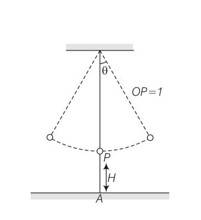
This is a long answer type question as classified in NCERT Exemplar
Let us assume t=0 when o then = 0coswt
Given a seconds pendulum w=2
=
At time t, let
Cos2 , t1=1/6
=-( )sin2
t=t1=1/6
d =- sin
the linear velocity is u=-
the vertical component is Uy=
the horizontal component Ux=-
at the time it snaps the vertical height is
H’=H+l(1-cos )
Let the time require for fall be t , then
H’= H+l (1 )
Let the time required for fall be at t then
H’=uyt+1/2 gt2
1/2gt2+
t=
given that is small , hence neglecting terms of order and higher
t=
H’
t=
the distance travelled in the x direction is uxt to the left of where the bob is snapped
X= Uxt=
cos
X=
At the time of snapping , the bob was at a horizontal distance of from A
Thus, the distance of bob from A where it meets the ground is
=
=
=
Find the time period of mass M when displaced from its equilibrium positon and then released for the system shown in Fig.
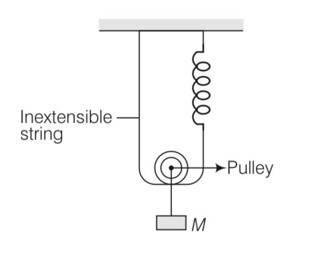
This is a short answer type question as classified in NCERT Exemplar
For calculation purpose, in this situation we will neglect gravity because it is constant throughout will not affect the net restoring force.
Let in the equilibrium position, the spring has extended by an amount xo
Let displacement by spring is and string be x .
But string is extensible so only spring will contribute in extension x+x=2x
So net extension is 2x+xo
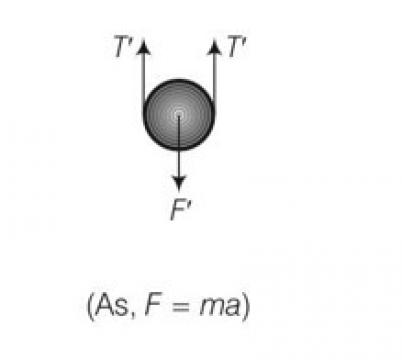
So force is F= 2T
T=kxo
F=2kxo
But when mass is lowered down further by x
F’=2T’ but spring length is 2x+xo
F’=2k (2x+xo)
Restoring force on the system
Frestoring=- (F’-F)
So using above equations
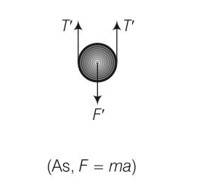
Frestoring= [2k (2x+x0)-2Kxo]=-4kx
Ma=-4kx
So a is directly proportional to negative displacement so it follows SHM.
So time period is T=
w= so T= 2
Show that the motion of a particle represented by y = sinω t – cos ω t is simple harmonic with a period of 2π/ω.
This is a short answer type question as classified in NCERT Exemplar
As we know displacement y=sinwt-coswt
=
=
=
To comparing with standard equation
Y= asin (wt+ )
So T=2 /w
Find the displacement of a simple harmonic oscillator at which its P.E. is half of the maximum energy of the oscillator.
This is a short answer type question as classified in NCERT Exemplar
Let us assume that the required displacement be x
Potential energy of the simple harmonic oscillator =1/2 kx2
k= force constant=mw2
PE= ½ mw2x2
Maximum energy of oscillator
TE= ½ mw2A2
PE=1/2 TE
½ mw2x2=
So x= =
A body of mass m is situated in a potential field U(x) = U0 (1-cos αx) when U0 and α are constants. Find the time period of small oscillations.
This is a short answer type question as classified in NCERT Exemplar
given potential energy associated with the field
U (x)=Uo (1-cos )
F=-dU (x)/dx
F=-d (Uo-Uocos )=-Uo sin
F=-Uo
F
Motion is SHM for small oscillatons
F=-mw2X
Mw2=Uo
w2= , w=
T= =
A mass of 2 kg is attached to the spring of spring constant 50 Nm-1. The block is pulled to a distance of 5cm from its equilibrium position at x = 0 on a horizontal frictionless surface from rest at t = 0. Write the expression for its displacement at anytime t.
This is a short answer type question as classified in NCERT Exemplar
Consider the diagram of the spring block system. It is a SHM with amplitude of 5cm about the mean position
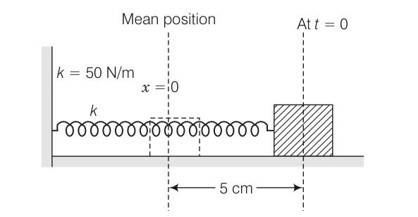
Spring constant k=50N/m
Mass =2kg
Angular frequency w=
Y (t)= Asin (wt+ )
Y (0)=Asin (w )
sin =1
y (t)=Asin (wt+ = Acoswt
A=5cm w=5rad/s
Y=5sin5t
Consider a pair of identical pendulums, which oscillate with equal amplitude independently such that when one pendulum is at its extreme position making an angle of 2° to the right with the vertical, the other pendulum makes an angle of 1° to the left of the vertical. What is the phase difference between the pendulums?
This is a short answer type question as classified in NCERT Exemplar
By considering the diagram
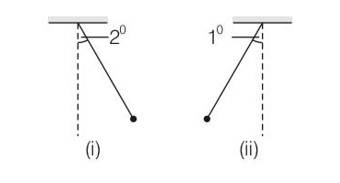
1=
2=
As it is clear given that amplitude time period being equal but phases being different. Now for first pendulum at any time t
1= 2
So sin = sin(wt+ )
wt+
where o=2o is the angular amplitude of first pendulum . for the second pendulum , the angular displacement is one degree , therefore 2= and negative sign is taken to show for being left to mean position.
-
Sin(wt+ )=-1/2
So (wt+ 2)=-
So by making their difference
(wt+ 2)-( 1)=7 =4
( 2- 1)= 1200
The displacement of a particle is represented by the equation y = 3cos( ). The motion of the particle is
(a) Simple harmonic with period 2 /w.
(b) Simple harmonic with period π/ω.
(c) Periodic but not simple harmonic.
(d) Non-periodic.
This is a multiple choice answer as classified in NCERT Exemplar
Velocity =dy/dt=
= 3 (-2w) [-sin ( )]
= 6wsin
Acceleration a = dv/dt=
= -4w2 [3cos ( )]
A = -4w2y hence acceleration is directly proportional to displacement so it follows SHM
w’= 2w
2
T’= 2 =
The displacement of a particle is represented by the equation 3 y t = sin ω . The motion is
(a) Non-periodic.
(b) Periodic but not simple harmonic.
(c) Simple harmonic with period 2π/ω.
(d) Simple harmonic with period π/ω.
This is a multiple choice answer as classified in NCERT Exemplar
(b) y = sin3wt
= [3sinwt-4sin3wt]/4
dy/dt= [ ]/4
4dy/dt=3wcoswt-4 [3wcoswt]
4
= -
is not proportional to y. hence it is not SHM.
The relation between acceleration and displacement of four particles are given below:
(a) ax = + 2x.
(b) ax = + 2x2.
(c) ax = – 2x2.
(d) ax = – 2x. Which one of the particles is executing simple harmonic motion?
This is a multiple choice answer as classified in NCERT Exemplar
(d) For motion to be in SHM acceleration of the particle must be proportional to negative of displacement.
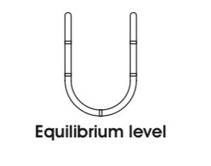
a , so y has to linear.
Motion of an oscillating liquid column in a U-tube is
(a) Periodic but not simple harmonic.
(b) Non-periodic.
(c) Simple harmonic and time period is independent of the density of the liquid.
(d) Simple harmonic and time-period is directly proportional to the density of the liquid.
This is a multiple choice answer as classified in NCERT Exemplar
(c) Consider the diagram in which a liquid column oscillates . in this case, restoring force acts on the liquid due to gravity.
Restoring force f = weight of liquid column of height 2y
t=-A = -2A
f
motion is SHM with force constant k= 2A
T= = 2
So time period is independent upon density of liquid.
A particle is acted simultaneously by mutually perpendicular simple hormonic motions x = a cos ωt and y = a sin ωt . The trajectory of motion of the particle will be
(a) An ellipse.
(b) A parabola.
(c) A circle.
(d) A straight line.
This is a multiple choice answer as classified in NCERT Exemplar
(c) x= acoswt
Y= asinwt
Squaring and adding above eqns
x2+y2=a2, this is the equation of circle
The displacement of a particle varies with time according to the relation y = a sin ωt + b cos ωt.
(a) The motion is oscillatory but not S.H.M.
(b) The motion is S.H.M. with amplitude a + b.
(c) The motion is S.H.M. with amplitude a2 + b2.
(d) The motion is S.H.M. with amplitude .
This is a multiple choice answer as classified in NCERT Exemplar
(d) y= asinwt + bcoswt
a=Asin and b= Acos
a2+b2=A2sin2 +A2cos2
A=
y=Asin +Acos
= Asin (wt+ )
dy/dt= Awcos (wt+ )
So it is proportional to displacement . so follows SHM
Four pendulums A, B, C and D are suspended from the same
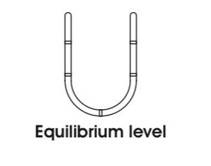
elastic support as shown in Fig. A and C are of the same length, while B is smaller than A and D is larger than A. If A is given a transverse displacement,
(a) D will vibrate with maximum amplitude.
(b) C will vibrate with maximum amplitude.
(c) B will vibrate with maximum amplitude.
(d) All the four will oscillate with equal amplitude.
This is a multiple choice answer as classified in NCERT Exemplar
(b) A is given a transverse displacement. Through the elastic support the disturbance is transferred to all the pendulums.
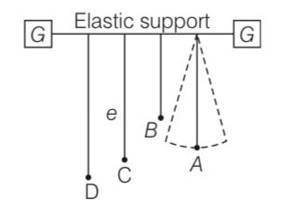
A and C are having same length hence they will be in resonance, because their time period of oscillation.
T= hence frequency is same. So amplitude of A and C will be maximum.Figure 14.2. shows the circular motion of a particle. The radius of the circle, the period, sense of revolution and the initial position are indicated on the figure. The simple harmonic motion of the x-projection of the radius vector of the rotating particle P is
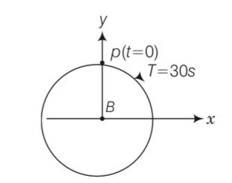
(a) x (t) = B sin(2 )
(b) x (t) = B cos(πt/15)
(c) x (t) = B sin( )
(d) x (t) = Bcos ( )
This is a multiple choice answer as classified in NCERT Exemplar
(a) Let angular velocity of the particle executing circular motion is w and when it is at O makes and angle
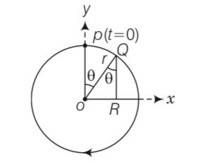
As =wt
OR=OQCos (90- )
= OQsin =OQsinwt
=rsinwt
x=rsinwt=Bsinwt
= Bsin =Bsin ( )
The equation of motion of a particle is x = a cos (α t ) 2. The motion is
(a) Periodic but not oscillatory.
(b) Periodic and oscillatory.
(c) Oscillatory but not periodic.
(d) Neither periodic nor oscillatory.
This is a multiple choice answer as classified in NCERT Exemplar
(c) x=acos ( )2, so it is SHM motion.
X (t+T)=acos [ ]2
= acos [ ]
So it is not periodic.
So it is oscillatory but not periodic
A particle executing S.H.M. has a maximum speed of 30 cm/s and a maximum acceleration of 60 cm/s2. The period of oscillation is
(a) π s.
(b) π/2 s.
(c) 2π s.
(d) π/t s.
This is a multiple choice answer as classified in NCERT Exemplar
(a) V=dy/dt=awcoswt
Vmax=aw=30
Acceleration A=
A=w2a=60
So after solving w =2rad/s
2
T=
When a mass m is connected individually to two springs S1 and S2, the oscillation frequencies are ν1 and ν2 . If the same mass is attached to the two springs as shown in Fig. 14.3, the oscillation frequency would be

(a) ν1 + ν2
(b)
(c) ( -1
(d)
This is a multiple choice answer as classified in NCERT Exemplar
(b) Keq= K1+K2

Time period of oscillation of the spring block system
T=2
Frequency = 1/time = = equivalent oscillation frequency
When the mass is connected to the springs individually
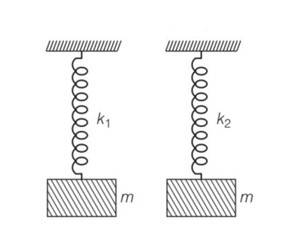
From above equation
So
The rotation of earth about its axis is
(a) Periodic motion.
(b) Simple harmonic motion.
(c) Periodic but not simple harmonic motion.
(d) Non-periodic motion.
This is a multiple choice answer as classified in NCERT Exemplar
(a), (c) the rotation of earth about its axis is periodic because it repeats after a regular interval of time.
The rotation of earth is obviously not a to and fro type of motion about a fixed point. So its motion is SHM.
Motion of a ball bearing inside a smooth curved bowl, when released from a point slightly above the lower point is
(a) Simple harmonic motion.
(b) Non-periodic motion.
(c) Periodic motion.
(d) Periodic but not S.H.M.
This is a multiple choice answer as classified in NCERT Exemplar
(a), (c) consider the motion of a ball inside a smooth curved bowl
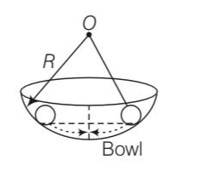
for small angular displacement or slightly released motion, it can be considered as angular SHM.
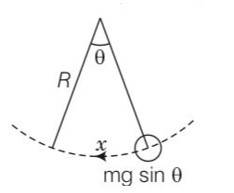
When the ball is at angle of the restoring force acts
Ma=mgsin
A= gsin
Hence motion is SHM
So T=
Displacement vs. time curve for a particle executing S.H.M. is shown in Fig. 14.4. Choose the correct statements. Fig. 14.4 Fig. 14.3
(a) Phase of the oscillator is same at t = 0 s and t = 2 s.
(b) Phase of the oscillator is same at t = 2 s and t = 6 s.
(c) Phase of the oscillator is same at t = 1 s and t = 7 s.
(d) Phase of the oscillator is same at t = 1 s and t = 5 s.
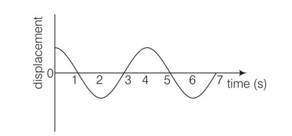
This is a multiple choice answer as classified in NCERT Exemplar
(b), (d) It is clear the curve that points corresponding to t=2s and t=6s are separated by a distance belongs to one time period. hence these points must be in same phase
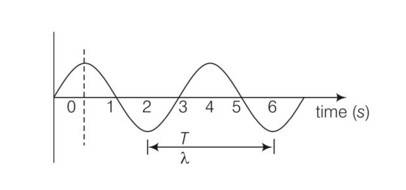
Similarly points belongs t-1s to t=5sare at separation of one time period. Hence must be in phase.
Which of the following statements is/are true for a simple harmonic oscillator?
(a) Force acting is directly proportional to displacement from the mean position and opposite to it
(b) Motion is periodic.
(c) Acceleration of the oscillator is constant.
(d) The velocity is periodic.
This is a multiple choice answer as classified in NCERT Exemplar
(a, b, d) x=asinwt
V=dx/dt=awcoswt
A=dv/dt=-aw2sinwt
Force = mass = -mw2x
So force is directly proportional to displacement.
The displacement time graph of a particle executing S.H.M. is shown in Fig. 14.5. Which of the following statement is/are true?
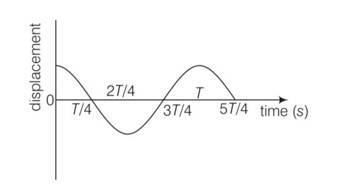
(a) The force is zero at t =3T/4 .
(b) The acceleration is maximum at t = 4T/4.
(c) The velocity is maximum at t = T/4.
(d) The P.E. is equal to K.E. of oscillation at t = T/2 .
This is a multiple choice answer as classified in NCERT Exemplar
(a, b, c) At t= 3T/4, the displacement of the particle is zero. Hence particle executing SHM will be at mean position i.e x=0 acceleration is zero and force is also zero.
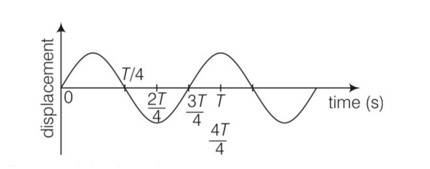
At t= 4T/3, displacement is maximum i.e extreme position, so acceleration is maximum
At t = T/4 corresponds to mean position, so velocity will be maximum at this position.
At t= T/2 corresponds to extreme position so KE =0 and PE =maximum.
A body is performing S.H.M. Then its
(a) Average total energy per cycle is equal to its maximum kinetic energy.
(b) Average kinetic energy per cycle is equal to half of its maximum kinetic energy.
(c) Mean velocity over a complete cycle is equal to 2 π times of its maximum velocity.
(d) Root mean square velocity is 1/√ 2 times of its maximum velocity
This is a multiple choice answer as classified in NCERT Exemplar
(a, b, d) a) total mechanical energy of the body at any time t is
E= w2a2
KE=1/2mv2=
Kmax= ½ mw2a2=E
b) K= ½ mw2a2cos2wt
for a cycle value of coswt is =1/2
= 1/4 mw2a2= kmax/2
c) v=dx/dt = a coswt
Vmaen =Vmax+Vmin/2
= aw-aw/2=0
d)Vrms=
Vrms=Vmax/
A particle is in linear simple harmonic motion between two points A and B, 10 cm apart (Fig.). Take the direction from A to B as the + ve direction and choose the correct statements

(a) The sign of velocity, acceleration and force on the particle when it is 3 cm away from A going towards B are positive.
(b) The sign of velocity of the particle at C going towards O is negative.
(c) The sign of velocity, acceleration and force on the particle when it is 4 cm away from B going towards A are negative.
(d) The sign of acceleration and force on the particle when it is at point B is negative
This is a multiple choice answer as classified in NCERT Exemplar
(a, c, d) a) when the particle is 3 cm away from A going towards B, velocity is towards AB.i.e positive. SHM towards mean position so positive.
b) When the particle is at C velocity is towards B hence positive.
c) When the particle is 4 cm away from B is going towards A velocity is negative and acceleration towards mean position. Hence negative.
d) Acceleration is always towards mean position O. when the particle is at B acceleration and force are towards BA that is negative.
Displacement versus time curve for a particle executing S.H.M. is shown in Fig. 14.7. Identify the points marked at which
(i) velocity of the oscillator is zero,
(ii) speed of the oscillator is maximum.
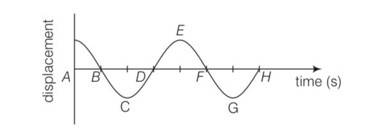
This is a multiple choice answer as classified in NCERT Exemplar
(i) In SHM y-t graph, zero displacement values correspond to mean position where velocity of the oscillator is maximum.
Where the crest and troughs represents extreme positions where displacement is maximum and velocity of the oscillator is minimum and is zero. Hence A (ii) And also speed is maximum at mean position represented by B
Two identical springs of spring constant K are attached to a block of mass m and to fixed supports as shown in Fig. When the mass is displaced from equilibrium position by a distance x towards right, find the restoring force.
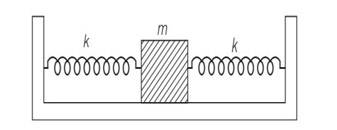
This is a multiple choice answer as classified in NCERT Exemplar
Consider the diagram in which the block is displaced right through x
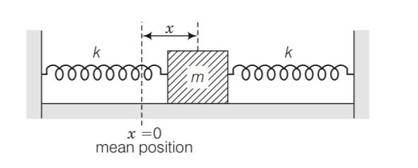
The right spring gets compressed by x developing a restoring force kx towards left on the block. The left spring is stretched by an amount x developing a restoring force kx towards left on the block

Hence total force =kx+kx= 2kx towards left.
What are the two basic characteristics of a simple harmonic motion?
This is a multiple choice answer as classified in NCERT Exemplar
Acceleration is directly proportional to displacement.
The direction of acceleration is always towards the mean position that is opposite to displacement.
When will the motion of a simple pendulum be simple harmonic
This is a multiple choice answer as classified in NCERT Exemplar
The bob is displaced through some angle
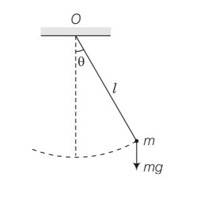
The restoring force if is small then it is only.
So torque is directly proportional to angle.
So it clear from the above equation that its period will be harmonic
What is the ratio of minimum acceleration to the maximum velocity of a simple harmonic oscillator?
This is a multiple choice answer as classified in NCERT Exemplar
As we know equation of SHM is x= Asinwt
V= dx/dt=Awsinwt
Vmax=Awcoswtmax
= Aw
A=dv/dt=-wAwsinwt
= -w2Asinwt
Amax=-w2A
From above equations
=wA/w2A=1/w
What is the ratio between the distance travelled by the oscillator in one time period and amplitude?
This is a multiple choice answer as classified in NCERT Exemplar
In the diagram

the motion of a particle executing SHM between A and B
Total distance travelled while it goes from A to B and returns to A is=AO+OB+BO+OA
= A+A+A+A=4A
So ratio of distance and amplitude =4A/A=4
In Fig, what will be the sign of the velocity of the point P′ , which is the projection of the velocity of the reference particle P . P is moving in a circle of radius R in anticlockwise direction.
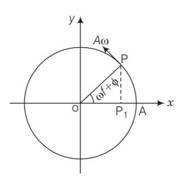
This is a multiple choice answer as classified in NCERT Exemplar
As the particle on reference circle moves in anticlockwise direction. The projection will move from P to O towards left.
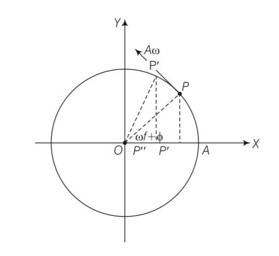
Hence in the position shown the velocity is directed from P’ to P’’ i.e from right to left . hence sign is negative.
Show that for a particle executing S.H.M, velocity and displacement have a phase difference of π/2.
This is a multiple choice answer as classified in NCERT Exemplar
As we know x= acoswt
V =dx/dt= a (-sinwt)w=-wasinwt
V=-wasinwt
= wacos ( )
Phase of velocity =
So difference in phse of velocity to that of phase of displacement = =
Draw a graph to show the variation of P.E., K.E. and total energy of a simple harmonic oscillator with displacement.
This is a multiple choice answer as classified in NCERT Exemplar
Potential energy of a simple harmonic oscillator is = ½ kx2=1/2mw2x2
K=mw2
When x=0 PE=0
When x= , PE=maximum
=1/2 mw2A2
KE of a simple harmonic oscillator =1/2 mv2
= 1/2 m [w ] 2
= ½ mw2 (A2-x2)
This is also parabola if plot KE against displacement x
KE= 0 at x=
KE=1/2mw2A2 at x=0
Now total energy of the simple harmonic oscillator =PE+KE
= ½ mw2x2+1/2mw2 (A2-x2)
TE= ½ mw2A2
So the curve according to that is
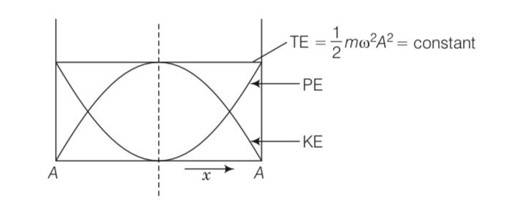
The length of a second’s pendulum on the surface of Earth is 1m. What will be the length of a second’s pendulum on the moon?
This is a multiple choice answer as classified in NCERT Exemplar
Time period of simple pendulum T=2s
For simple pendulum T= where l is length and g = acceleration due to gravity.
Te=2
On the surface of the moon Tm= 2
=
Te=Tm to maintain the second’s pendulum time period
1= …………….1
But the acceleration due to gravity at moon is 1/6 of the acceleration due to gravity at earth,
gm=
squaring equation 1 and putting this value
1=
lm=1/6le = 1/6 m
Physics NCERT Exemplar Solutions Class 11th Chapter Fourteen Exam
